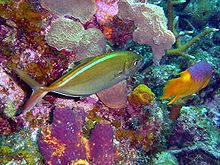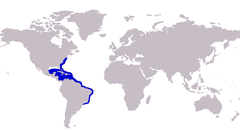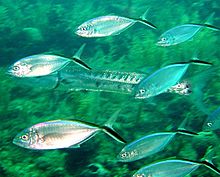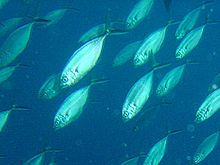- Bar jack
-
"Red jack" redirects here. For the playing card, see Jack (playing card). For pseudonym of the serial killer, see Jack the Ripper.
Bar jack 
Scientific classification Kingdom: Animalia Phylum: Chordata Class: Actinopterygii Order: Perciformes Suborder: Percoidei Superfamily: Percoidea Family: Carangidae Genus: Carangoides Species: C. ruber Binomial name Carangoides ruber
(Bloch, 1793)Approximate range of the bar jack Synonyms - Somber ruber Bloch, 1793
- Caranx ruber (Bloch, 1793)
The bar jack, Carangoides ruber (also known as the carbonero, red jack, blue-striped cavalla and passing jack) is a common species of inshore marine fish classified in the jack family, Carangidae. The bar jack is distributed through the western Atlantic Ocean from New Jersey and Bermuda in the north to Venezuela and possibly Brazil in the south, with the largest population in the Gulf of Mexico and West Indies. The bar jack is most simply distinguished from similar jacks by its dark horizontal bar which runs along the back and down the caudal fin, often accompanied by an electric blue stripe immediately below it. Other more detailed differences include dentition and soft ray counts. The bar jack is a moderately large species, growing to a recorded maximum of 65 cm and a weight of 6.8 kg. The species inhabits clear shallow waters, often over coral reefs where it lives either solitarily or in large schools, taking various fishes, crustaceans and cephalopods as prey. Studies in Cuba indicate spawning occurs between March and August, with sexual maturity reached at 26 cm. It is a relatively popular sport fish and can be caught on light tackle with a variety of lures and baits. It is considered to be a good food fish, however many recorded ciguatera cases are attributed to the species, with most cases reported on the island of St. Thomas traced to this single species.
Contents
Taxonomy and naming
The bar jack is classified within the genus Carangoides, a group of fishes commonly known as jacks and trevallies, which is part of the larger jack and horse mackerel family Carangidae. The Carangidae are perciform fishes in the suborder Percoidei.[1] The fish is still often classified in the genus Caranx by most authors, including in the most recent review of the species by William Smith-Vaniz,[2] but the major taxonomic authorities Fishbase and ITIS both list it as under Carangoides, which this article follows.
The bar jack was first scientifically described under the name Somber ruber by Marcus Bloch, in 1793 based on a specimen taken from the east coast of America, which was designated to be the holotype.[3] Carangoides is derived from the French word, carangue, or a fish from the Caribbean, while ruber (sometimes incorrectly spelled rubber) is Latin for red.[4] Bloch attributed the species to the mackerels of the genus Scomber, a common practice during this period as the genus Caranx and subsequent family Carangidae were not created until 1801 by Bernard Germain de Lacépède. The species has been variably placed in either Carangoides or Caranx since 1801, with the status of the species still somewhat ambiguous.[2] A recent study of the molecular systematics of the Carangidae using mitochondrial cytochrome b sequences strongly supported placement in the genus Caranx, with C. ruber being most closely related to Caranx bartholomaei, itself still often classified under Carangoides. Both C. ruber and C. bartholomaei were strongly related to other well known members of Caranx, and only distantly related to any other species of Carangoides.[5]
Aside from the most commonly used name of "bar jack", other common names for this fish include blue-striped cavalla, red jack, neverbite, passing jack, and pointnose, as well as many non-English names.[6]
Description
The bar jack is a moderately large species, growing to a recorded maximum length of 69 cm, and a weight of 6.8 kg,[6] but is commonly encountered at lengths of less than 40 cm. The bar jack displays the typical body shape of most of the jacks, having an elongate, moderately deep and compressed form, with dorsal and ventral profiles of approximately equal convexity.[2] The dorsal fin is divided into two sections, the first consisting of 8 spines while the second has 1 spine followed by 26 to 30 soft rays. The anal fin is composed of 2 anteriorly detached spines followed by 1 spine and 23 to 26 soft rays, with both the anal and soft dorsal fin lobes being slightly elongated.[7] The pectoral fins are falcate and longer than the head, consisting of 19 to 21 soft rays. The lateral line is moderately arched anteriorly, and possesses 17 to 104 scales including 23 to 29 scutes posteriorly; also having bilateral paired caudal keels present.[7] The chest is completely scaled, which easily distinguishes it from the similar crevalle jack, Caranx hippos. The snout is moderately pointed, with both the jaws containing narrow bands of villiform teeth, with the bands becoming wider anteriorly. The upper jaw also contains an outer row of enlarged recurved teeth. There are 10 to 14 upper limb gill rakers, and 31 to 38 on the lower limb and 24 vertebrae.[7]
The bar jack has a gray to grayish blue upper body with a silvery tint, which fades ventrally to a white belly. As indicated by their common name, adult bar jack have a horizontal stripe running along their back and through the lower lobe of the caudal fin. This bar is a golden brownish to blackish color, often with an electric blue bar running parallel immediately underneath it. All other fins are pale dusky to hyaline.[8] Juveniles have up to 6 dark bands on their body and a darker lower caudal lobe than the upper lobe, foreshadowing the bar that develops at a later stage. At these early stages, they are difficult to distinguish from Carangoides bartholomaei,[9] with the best identifier being gill raker counts.[10] The entire body has been observed to change colour to a blackish colour when the fish is feeding near the bottom.[11]
Distribution and habitat
The bar jack is widely distributed through the tropical and subtropical waters of the western Atlantic Ocean, and is a common species throughout most of its range.[2] The northernmost limit of its range is New Jersey in the northern United States, with its range extending south along the continental coast to Venezuela. It inhabits a number of offshore islands and archipelagos including Bermuda, as well as the West Indies.[6] The bar jack is most abundant in the Gulf of Mexico, the West Indies and Caribbean, but in the Gulf of Mexico is limited to offshore waters. There have been reliable reports of the species from Rio de Janeiro in Brazil and far offshore at Saint Helena in the south central Atlantic,[12] which would extend the species southern limit significantly if correct.[2]
The bar jack generally live in clear shallow water environments, predominantly around coral reefs to depths of around 60 ft. Tagging studies demonstrate the species is highly mobile, not lingering over one particular reef patch for very long, often moving between reefs over large expanses of sand.[13] Bar jack often venture into lagoons from seaward reefs, preferring to move over the sandy substrate while in these shallow waters, often forming shoals alongside barracuda, stingrays and sharks. Unlike most fish live on both the lagoon and reef, there is no particular age partitioning, with both juveniles and adults entering the lagoon to forage.[14] Records of bar jack taken from Saint Helena came from seamounts in waters deeper than 100 m, indicating they live in more offshore pelagic waters also.[12] Juveniles are often found under floating sargassum mats, using the algae for protection. They also inhabit areas around docks and pilings. Juveniles can be caught using a sabiki rig.[11]
Biology
The diet and reproductive biology of the bar jack are relatively well documented, with most studies centered around the waters of Cuba during the 1980s, with nearly all of this research published in the Russian publication Voprosy Ikhtiologii, reprinted in English as the Journal of Ichthyology. The movements of the species between patches has also been studied and is presented above. The bar jack is commonly taken as prey by a number of other large carangids as well as dolphinfish, mackerels, marlins and various seabirds.[6]
Diet and feeding
 A bar jack foraging alongside a Spanish hogfish on a coral reef. Note the sight colour change on the dorsal surface
A bar jack foraging alongside a Spanish hogfish on a coral reef. Note the sight colour change on the dorsal surface
The bar jack is a benthopelagic predator, taking its prey both in midwater and along the seafloor. The diet consists mostly of fish, up to 90% of the fishes intake in some studies, with planktonic crustaceans and small cephalopods taken in minor volumes.[15] There is significant change in diet with age in fish studied off Cuba, which may reduce intraspecific competition in the species. Young fish prefer planktonic organisms, predominantly decapod and fish larvae; fish reaching sexual maturity prey on shrimp and small fish, while mature fish feed almost exclusively on small fish.[15] The fish species preferred by bar jack appear to be mostly small sand dwellers such as blennies and gobies or small reef dwellers including wrasses, butterflyfish and filefish, with the diet of the latter leading to the accumulation of coral derived ciguatera toxin in the jack's flesh.[15] Other lesser taken prey items include gastropods, nematodes and benthic algae as well as a range of crustaceans.[16]
Feeding intensity varies throughout the year, and is strongly correlated to changes in the precipitation and wind during cyclical shifts in the climate. Young fish tend to feed intensively throughout the year, but show a peak in the spring and autumn months, while adults intensify their feeding during the dry and rainy seasons, with feeding declining during intermediate periods (winter and early summer).[17] Daily intakes during the period of intensive feeding reach 3–7% of the fishes body weight, and during the periods of decline to 0.5–2%, with the annual intake being 1000–1500% of the body weight.[17] In a 1993 paper, Troy Baird reported a foraging association between bar jacks and puddingwife wrasse, Halichoeres radiatus, in which a jack followed a single wrasse while it foraged for food. These associations were initiated by both jacks and wrasse, with apparently little pilfering of uncovered items, suggesting a beneficial relationship to both parties.[16] While foraging with the wrasse, the jack increases its prey detection levels, which is useful for a species which is more adept at pelagic hunting, allowing it to be more efficient at this less common mode of food gathering.[16]
Reproduction and growth
The bar jack spawns twice each year, with this timing related to seasonal changes as described previously. During the peak feeding periods, the fish accumulate body fat in preparation for spawning, which occurs through the period from March to August in Cuba, with peaks during March–April and June–July.[18] Fish congregate in schools of hundreds to spawn, with pairs of fish breaking away to spawn. Studies have found between 67 000 and 231 000 eggs are released by each female, with fertilisation occurring externally. The eggs are pelagic and around 0.75 mm to 0.85 mm in diameter,[19] hatching when the larvae are around 2 mm in length, and flexion occurs at 4–5 mm. The larval stage of the bar jack has been extensively described by Richards (2006).[20] Larvae appear between April and October in the Gulf Stream current, and grow the fastest during their first three years of life.[21] During this early stage of life they are very similar to Carangoides bartholomaei, and often form associations with floating pelagic Sargassum mats which provide the young fish with protection. Young fish often inhabit the shallow reef waters, but move offshore once they reach sexual maturity. Due to a lack of discernible otolith rings, no studies on the growth of the bar jack have been published.[19] Males and females reach sexual maturity at different lengths; males at 25 cm and females at 31 cm.[22]
Relationship to humans
The bar jack is of minor to intermediate importance to fisheries through its range; both commercially and to recreational fishermen. Archaeological evidence from San Salvador Island in the Bahamas demonstrates this species has long been targeted by humans for food, with the native Indians of the region often taking the bar jack for consumption, although it was of lesser importance than reef fishes such as parrotfishes and groupers.[23] Modern fisheries take considerable quantities of the fish, but it rarely makes up the bulk of the catch. Catch statistics are not available for most countries. The United States reports only a small catch of between 0 and 15 tonnes per year, but with the abundance of the species in the Caribbean, larger catches are made here.[6] The bar jack is somewhat shy of baited hooks and is therefore taken predominantly by trawls and seines. It is marketed fresh in the Antilles and Bahamas, with its edibility rated fair to very good.[2]
The bar jack is a popular light tackle game fish, taken predominantly on small lures and flies, with the species considered to be an excellent fighter on light tackle. The species is often sighted working small baitfish to the surface, where they can be targeted with surface poppers or various fly patterns. As mentioned previously, they rarely take baited hooks. The species is often used as bait for larger game fish such as marlin and sailfish.[24] The bar jack has a significant risk of carrying the ciguatera toxin in its flesh, and numerous reports of people contracting the poisoning after consuming the fish. A comprehensive study of the toxin in the West Indies listed the bar jack as a species of intermediate risk of carrying the toxin,[25] although most cases in St. Thomas of the Virgin Islands can be traced back to the bar jack.[26]
References
- ^ " Carangoides ruber ". Integrated Taxonomic Information System. http://www.itis.gov/servlet/SingleRpt/SingleRpt?search_topic=TSN&search_value=168615. Retrieved 29 March 2008.
- ^ a b c d e f Carpenter, K.E. (ed.) (2002). The living marine resources of the Western Central Atlantic. Volume 3: Bony fishes part 2 (Opistognathidae to Molidae), sea turtles and marine mammals. FAO Species Identification Guide for Fishery Purposes and American Society of Ichthyologists and Herpetologists Special Publication No. 5. Rome: FAO. pp. 1438. ISBN 92-5-104827-4. ftp://ftp.fao.org/docrep/fao/009/y4162e/y4162e00.pdf.
- ^ California Academy of Sciences: Ichthyology (April 2008). "Scomber ruber". Catalog of Fishes. CAS. http://research.calacademy.org/research/ichthyology/catalog/fishcatget.asp?spid=15399. Retrieved 2008-11-19.
- ^ Perrota, Tina (2004). "Bar Jack". Ichthyology. Florida Museum of Natural History. http://www.flmnh.ufl.edu/fish/Gallery/Descript/barjack/barjack.html. Retrieved 2008-11-19.
- ^ Reed, David L.; Carpenter, Kent E. & deGravelle, Martin J. (2002). "Molecular systematics of the Jacks (Perciformes: Carangidae) based on mitochondrial cytochrome b sequences using parsimony, likelihood, and Bayesian approaches". Molecular Phylogenetics and Evolution 23 (3): 513–524. doi:10.1016/S1055-7903(02)00036-2. PMID 12099802.
- ^ a b c d e Froese, Rainer, and Daniel Pauly, eds. (2008). "Carangoides ruber" in FishBase. 11 2008 version.
- ^ a b c McEachran,, John D.; Janice D. Fechhelm (2005). Fishes of the Gulf of Mexico: Volume 2. University of Texas Press. pp. 280. ISBN 9780292706347.
- ^ Goodson, Gar; Phillip J. Weisgerber (1985). Fishes of the Atlantic Coast: Canada to Brazil, Including the Gulf of Mexico, Florida, Bermuda, the Bahamas, and the Caribbean. Stanford University Press. pp. 204. ISBN 9780804712682.
- ^ Nichols, John T. (1937). "Young Caranx ruber (Bloch)". Copeia 1937 (4): 236–237. doi:10.2307/1436277. ISSN 0045-8511. JSTOR 1436277.
- ^ Nichols, John T. (1920). "Caranx bartholomaei and ruber compared". Copeia 81 (1): 28–29. ISSN 0045-8511.
- ^ a b Schultz, Ken (2004). Ken Schultz's Field Guide to Saltwater Fish. John Wiley and Sons. pp. 288. ISBN 9780471449959.
- ^ a b Edwards, A.J. (1993). "New records of fishes from the Bonaparte Seamount and Saint-Helena Island, South Atlantic". Journal of Natural History 27 (2): 493–503. doi:10.1080/00222939300770241.
- ^ Chapman, Matthew R.; Donald L. Kramer (2000). "Movements of fishes within and among fringing coral reefs in Barbados". Environmental Biology of Fishes 57 (1): 11–24. doi:10.1023/A:1004545724503.
- ^ Gratwicke, Brian; Clive Petrovic & Martin R. Speight (2006). "Fish distribution and ontogenetic habitat preferences in non-estuarine lagoons and adjacent reefs". Environmental Biology of Fishes 76 (2–4): 191–210. doi:10.1007/s10641-006-9021-8.
- ^ a b c Popova, O.A.; L. Sierra (1983). "Diet of the bar jack Caranx ruber (Carangidae) on the Cuban Shelf in Batabano Bay 1. Seasonal and age related fattening dynamics". Voprosy Ikhtiologii 23 (3): 460–468. ISSN 0032-9452.
- ^ a b c Baird, Troy A. (1993). "A new heterospecific foraging association between the puddingwife wrasse, Halichoeres radiatus, and the bar jack, Caranx ruber: evaluation of the foraging consequences". Environmental Biology of Fishes 38 (4): 393–397. doi:10.1007/BF00007535.
- ^ a b Popova, O.A.; L.M. Sierra (1985). "Feeding of black jack, Caranx ruber, in the Gulf of Batabano on the Cuban shelf 2. Digestion rate and daily rations". Voprosy Ikhtiologii 25 (5): 808–820. ISSN 0032-9452.
- ^ Bustamante, G. (1989). "Ecophysiological aspects of reproduction of the bar jack Caranx ruber (Pisces:Carangidae) in the southwestern region of Cuba". Tropical Ecology 30 (2): 205–217. ISSN 0564-3295.
- ^ a b Thompson, R.; J.L. Munro (1974). "The Biology, Ecology and Bionomics of the Jacks, Carangidae". In J.L. Munro. Caribbean Coral Reef Fishery Resources. Manilla: International Center for Living Aquatic Resources Management. pp. 82–94. ISBN 971-102241-X.
- ^ Richards, William J. (2006). Early Stages of Atlantic Fishes: An Identification Guide for the Western Central North Atlantic. CRC Press. pp. 2640 pp. ISBN 9780849319167.
- ^ Leak, J.C. (1981). "Distribution and abundance of carangid fish larvaein the eastern Gulf of Mexico 1971-1974". Biological Oceanography 1 (1): 1–28. ISSN 0196-5581.
- ^ Garcia-Artega, H.P.; Y.S. Reshetnikov (1985). "Age and growth of the black jack, Caranx ruber near Cuban coasts". Voprosy Ikhtiologii 25 (5): 844–854. ISSN 0032-9452.
- ^ Wing, Elizabeth S. (1969). "Vertebrate Remains Excavated from San Salvador Island, Bahamas". Caribbean Journal of Science 9 (1–2): 25–29. ISSN 0799-0901.
- ^ Thomas Jr., E. Donnall; E. Donnall Thomas (2007). Redfish, Bluefish, Sheefish, Snook: Far-Flung Tales of Fly-Fishing Adventure. Skyhorse Publishing Inc. pp. 256. ISBN 9781602391192.
- ^ Bourdeau, P. (1992). "Ciguatoxic fish in the French West Indies". Bulletin de la Societe de Pathologie Exotique 85 (5/2): 415–418. ISSN 0037-9085.
- ^ Morris, J.G.; P. Lewin, C.W. Smith, P.A. Blake & R. Schneider (1982). "Ciguatera Fish Poisoning - Epidemiology of the Disease on St. Thomas, United States Virgin Islands". American Journal of Tropical Health and Medicine 31 (3): 574–578. ISSN 0002-9637.
External links
Categories:- Carangoides
- Fish of the Atlantic Ocean
- Sport fish
Wikimedia Foundation. 2010.



